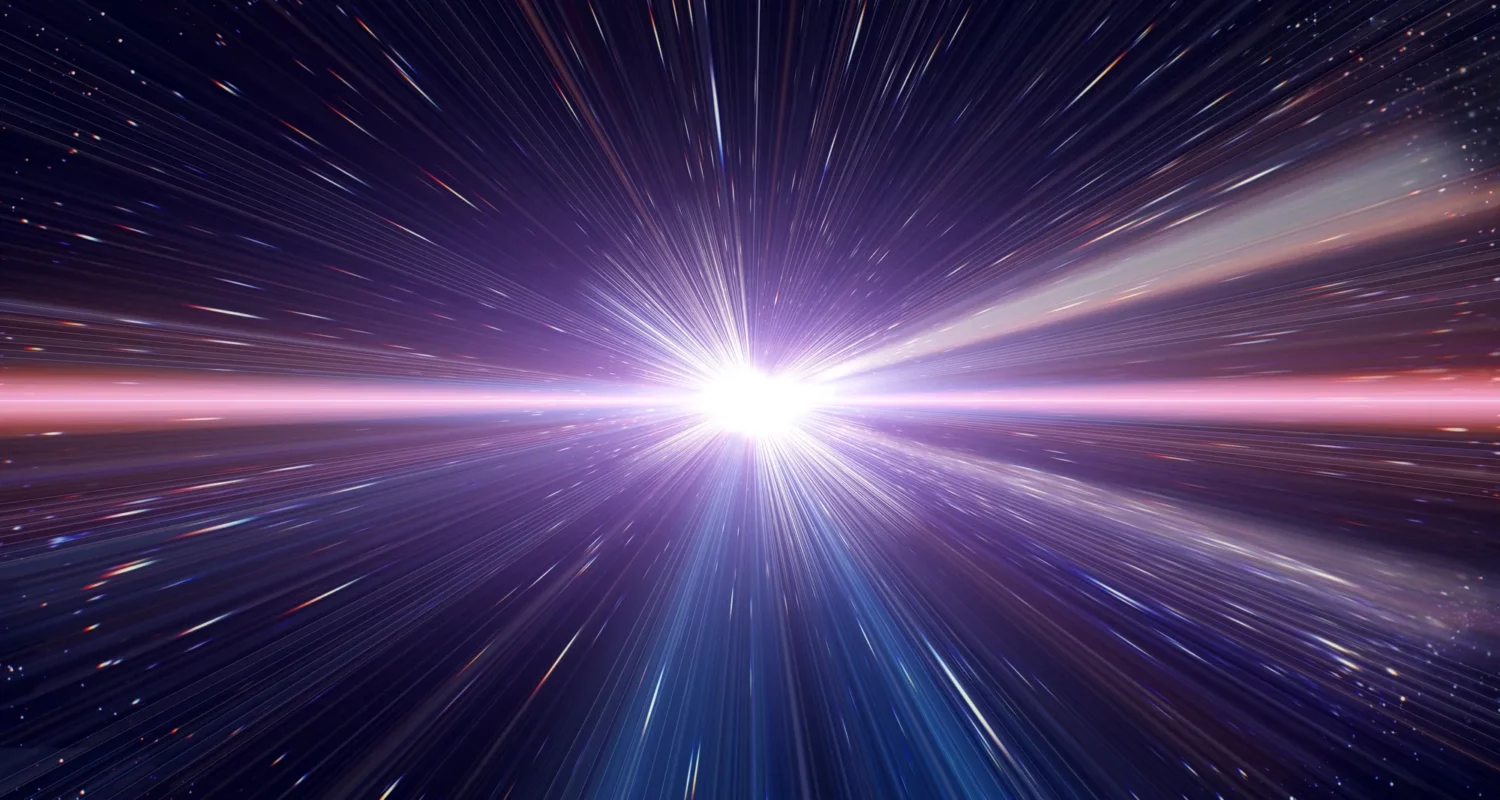The Millennium Falcon, the beloved ship of Han Solo and Chewbacca in the Star Wars movies, can travel faster than the speed of light by activating a propulsion system called hyperdrive.
However, even with the latest technology, we modern people have not yet been able to achieve the technology to travel at the speed of light.
It’s not that it’s “not yet possible,” but rather that traveling at the speed of light is “impossible according to the laws of physics.”
But this time, let’s set aside those limitations and take a look at science fiction to see what kind of experiences humans could have if they could travel through space at the speed of light .
Anything with mass cannot reach the speed of light
The speed of light is very special.
It can reach a speed of 299,792 kilometers per second , which means it can circle the Earth seven and a half times in just one second .
So what exactly is special about the speed of light?
The secret was revealed by the ” special theory of relativity ” proposed by the genius physicist Einstein in 1905.
According to Einstein’s theory, “anything with mass cannot reach the speed of light . ”
Why is that?
According to the theory of special relativity, when an object with mass is accelerated, its mass increases accordingly.
By the time an object reaches the speed of light, its mass becomes infinite, and it would require an infinite amount of energy to keep it moving at the speed of light .
It is impossible to supply infinite energy, so if there is even a little mass, it is impossible to reach the speed of light.
However, very light objects can travel very close to the speed of light.
In fact , using the Large Hadron Collider (LHC), humans have succeeded in accelerating particles to 99.99999896% of the speed of light .
However, the flip side of this is that only things with zero mass can reach the speed of light .
In this case, the massless entity mainly refers to a “photon.”
Photons are particles that have no mass.
Anything with mass requires energy to accelerate, but a photon, which has zero mass, does not require energy to accelerate.
But conversely, photons cannot be stopped.
According to Einstein’s theory of relativity, when an object with zero mass moves at a speed other than the speed of light, the relationships between momentum and energy break down and the laws of physics break down.
In other words, photons have no mass and can only travel at the speed of light .
In the sense that you can’t stop, you could even say it’s inconvenient.
Based on all of this, a very realistic conclusion would be that no matter how hard a living human being with mass tries, they cannot move at the speed of light .
However, it would be boring to end it there, so here we will use a “magical power (= imagination)” that can ignore the laws of physics and accelerate humans up to the speed of light.
The “speed of light” is constant for everyone, but space-time is distorted
So let’s try accelerating a human to the speed of light! …and that’s when the problem begins.
From a practical standpoint, the human body cannot withstand such extreme acceleration.
If you accelerate too hard, the G forces ( after gravitational acceleration) acting on your body become too great and restrict blood flow to your extremities.
Fighter jets like the F15 can perform movements requiring 9G, but anything more than that will result in blood not circulating through the body and the person will black out (faint).
When it comes to accelerating to the speed of light, fighter jets are no match for it.
If you accelerated a living human being to the speed of light in just a few seconds, they would be crushed in an instant.
So here, we will wrap the human body in a “magic membrane” that protects it from any acceleration, and accelerate it up to the speed of light.
As the human body approaches the speed of light, phenomena that are impossible on Earth begin to occur.
First of all, anyone can see that the speed of light traveling in space is constant and does not change .
This is known as the “principle of the constancy of the speed of light” that Einstein demonstrated in his special theory of relativity .
For example, imagine a person wrapped in a magical membrane flying through space at 60% of the speed of light, with light passing them from the side.
If you think about it normally, the speed of light would appear to be 40% of the speed of light to someone traveling at 60% of the speed of light.
This is something we all experience on a daily basis.
For example, a car traveling at 60 km/h will appear to be traveling at 60 km/h to a person standing on the ground.
But to a car traveling at 40 kilometers per hour, it appears to be going 20 kilometers per hour, which is slower than it actually is. So when you are overtaken on the highway, the car appears to pass you slowly.
However, modern physics has shown that this does not happen at the speed of light in a vacuum .
In other words, the speed of light appears to be exactly the same, 299,792 kilometers per second, to both a person stationary in space and a person traveling at 70% of the speed of light .
However, if we accept the rule that “the speed of light is constant no matter who sees it,” a physical contradiction arises.
According to the laws of physics, a person traveling at 60% of the speed of light should see the speed of light as slower than normal, but this is not what actually happens.
So Einstein came up with a reversal of the idea to resolve this contradiction.
In other words, the principles of “time” and “space” are distorted so that the speed of light appears the same to anyone, regardless of the speed at which they are traveling .
As we learn in elementary school, speed is expressed as time x distance. In order to make the relative speed consistent no matter what speed you are looking at, the only way is to distort time and space.
Before Einstein, “time” and “space” were thought to be absolute and unchanging for everyone.
However, if the speed of light does not appear to change for anyone moving at any speed, then the idea is to adjust space-time so that the speed of light always appears constant (299,792 kilometers per second) for everyone.
For example, for a person traveling at 60% of the speed of light, time slows down so that the speed of light is 299,792 kilometers per second.
In short, our perception of “time” and “space” is not absolute; it changes relatively depending on the speed at which each person moves .
This is the basic meaning of Einstein’s “relativity.”
To give a simple example, one hour for a person on Earth is equivalent to one minute for a person traveling close to the speed of light .
The same phenomenon occurs in space, where a rod that appears 10 metres long to someone on the ground will appear to be shrunk to 1 meter to someone moving close to the speed of light.
More specifically, if you travel through space at close to the speed of light (sublight speed), how different will it be from someone on Earth?
Let’s take a quick blast to Mars at sublight speed.
How much time difference occurs when traveling at sub-light speed? What is the world like when the speed of light is reached?
A physical thought experiment suggests that someone traveling through space at sublight speed would age more slowly than someone waiting on Earth .
Now, let’s say you fly to Mars at 90% of the speed of light and then return to Earth.
If the total distance traveled was 450 million kilometers, traveling at sublight speed without stopping once, it would take approximately 16 minutes and 40 seconds for someone on Earth to travel that distance.
However, for someone traveling at sublight speed, only about 8 minutes and 20 seconds would pass.
Since it doesn’t seem to make much difference, I’ll try a more daring space trip.
Next, let’s look at Alpha Centauri, the closest star to our solar system, located about 4.3 light years away .
We’ll also increase the speed even further and travel between Earth and Alpha Centauri and back at 99.99% of the speed of light.
From the perspective of someone on Earth , approximately eight years and eight months had passed, but for someone traveling at sublight speed, it would have only been about a month and a half.
This means that while the travellers were on their journey for a little over a month, the people on Earth had aged by eight years.
This is the phenomenon we experience when traveling close to the speed of light: time dilation .
And it’s not just time that changes.
As your travel speed approaches the speed of light, the scenery changes.
The biggest change is in how the color of light appears; light from in front of you appears bluer and light from behind you appears redder .
This is due to the Doppler effect of light.
The Doppler effect is a phenomenon in which the frequency of a sound source changes as it moves, and is often compared to the sound of an ambulance siren .
As a siren approaches, the wavelength of the sound shrinks and it sounds higher-pitched, and as the siren moves away, the wavelength of the sound stretches and it sounds lower.
The same thing happens with light.
For someone traveling at sublight speeds, light approaches them from the front, so its wavelength becomes shorter and it is “blueshifted ,” appearing bluer.
Conversely, as the light from behind moves further and further away, its wavelength becomes longer and it undergoes a “redshift,” appearing reddish.
So if you were flying through space at sublight speed, you would see blue scenery if you looked ahead and red scenery if you looked backwards .
Finally, let’s remove the barrier of mass, make the human body mass zero, and reach the speed of light.
So what happens then?
First, time stops completely for an object traveling at the speed of light.
As proven by Einstein ‘s special theory of relativity , for objects moving at the speed of light, time does not pass and the flow of time does not exist.
Therefore, someone who reaches the speed of light would have an indescribable experience of time that could be interpreted as either “an instant” or “an eternity.”
Furthermore, for someone who has reached the speed of light, the wavelength of light in front of them would be infinitely short, and the wavelength of light behind them would be infinitely long, exceeding the range of what can be observed.
It may become impossible for us to even “see the light,” and we may be enveloped in a world of darkness .
A human traveling at the speed of light would probably not be able to see the passage of time or the beautiful scenery.
It must be an extremely restrictive world.
It could be said that it is thanks to mass that we are able to enjoy the free world we live in today.

